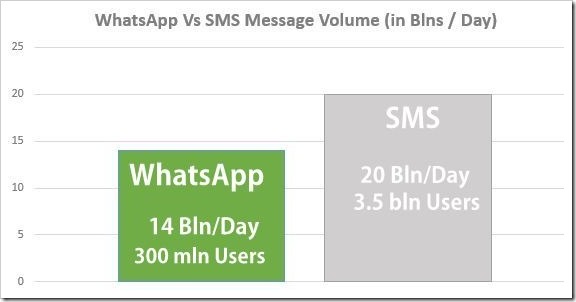WhatsApp Messages Volume Reaches 14 Bln A Day, Nearly 70% That Of SMSes
The ubiquitous ‘What’s Up’, meaning what is going on/how are you was exploited beautifully by the King of Beers Budweiser in their WASSUP campaign. Then, in 2009, two former employees of Yahoo! created something on the same name which revolutionized the mobile communications industry – cross-platform instant messaging subscription service for smartphones, which we today know as WhatsApp.
Consider these stats: Message volume at 14 billion a day, across 100 countries, on 750 mobile networks. Globally 300 million monthly active users. 25 million active users just in a country like India. The traditional SMS volume comparatively is estimated to have a volume of about 20 Billion a day. To put it perspective, SMS came into existence over 20 years back and currently has 3.5 billion active users. SMS is dying, there is no doubt about that and Whatsapp seems to be the biggest culprit behind that!

Mind boggling numbers? Read on…
The telecommunications industry is growing by leaps and bounds. Technologically and exponentially. Meaning new technology (read: smartphones are selling millions weekly) is fast gaining ground and what had happened in the last couple of decades is now happening in these couple of years! And every Tom, Dick and Harry worth his salt is trying to ride this wave. And WhatsApp seems to be the torchbearer.
Contents
Global or just India?
Take India’s example. A developing country with low internet penetration but growing at an exponential rate. From 20 million monthly active users in August 2013, it has crossed 25 million today, the kind of growth a bull run sensex also can’t give. This IM has become so popular that Idea Cellular had also mentioned during its earnings call that more than 4.3 million Idea connections had accessed WhatsApp in the last quarter (Q2-FY14), although strangely it had also mentioned that free messaging apps like WhatsApp were a threat to its non-data VAS revenues, whereas it is these same free applications which are driving the data usage on these networks, thereby growing Idea Cellular’s data VAS revenues.
No competitors?
Japanese mobile messaging application LINE had claimed to have hit 10 million registered users mark in India last month. Bharti-Softbank (BSB) backed Hike had also claimed to have 5 million registered users in April 2013. Tencent’s WeChat doesn’t provide any country-wide breakup but it had claimed to have crossed 100 million overseas users in August 2013.
Threat to SMS?
SMS is passe. Other than basic phone users, no one actually uses it. Irrespective of the fact that it is now available for as low as 1ps/sms. Did you ask why? Just because it is what Black and White movies are to today’s generations’ IMAX shot videos. The generation of SMS is at a sunset. Telcos who had made a killing by charging hefty charges for sms are now at a loss as SMS usage is dipping day by day.
Revenues hurt?
Not yet, but soon it will hit.
About 96% of India’s 900 million mobile connections are on pre-paid. To use either the free calling platforms that use IP platforms to route their calls, or to avail free instant messaging apps, customers must first buy a data plan. Be it a daily, weekly or monthly data plan, this is close to what mobile phone companies were making by selling SMS packs.
Unlike most global markets, SMS accounts for less than 5% of the total revenues of all major operators in the country, while for some telcos, this figure is as low as 2-3%. In comparison, SMS contributes 43% of the telcos’ sales in the Philippines, 23% in Indonesia, 18% in Singapore and 14.3% in Malaysia.
Therefore, the prospects of free instant messaging apps cannibalizing SMS revenues is yet to become a major threat in India. Put simply, OTT (over-the-top apps) is only additional new messaging and not cannibalized SMS.
Research on the money involved?
Credit Suisse analysts Sunil Tirumalai and Chunky Shah wrote in a 16 September research note: IP calls we tried on a 3G network in Mumbai used up 450 KB of data per minute, for each user. Using the average revenue per MB reported by Bharti/Idea (at 32p/MB—which incidentally is close to the rate implied in the popular Rs.103/300MB 3G plans), we calculate that a one minute VoIP call on Line works out to 30p/min—split evenly between the two parties. This comes at a 52% discount to the outgoing call rate of 62p/min implied in Bharti’s voice RPM.
Any disappointments?
WhatsApp is tightly integrated with phone number for identification and can’t function if the device isn’t able to receive the verification SMS — ironically. This is where SMS scores one point over the hundred which WhatsApp has scored.
Falling smartphone prices make India the fastest growing market for these apps. May be soon, just like the last telegram we sent couple of months ago, the time has come to send the last SMS too.
